Photo
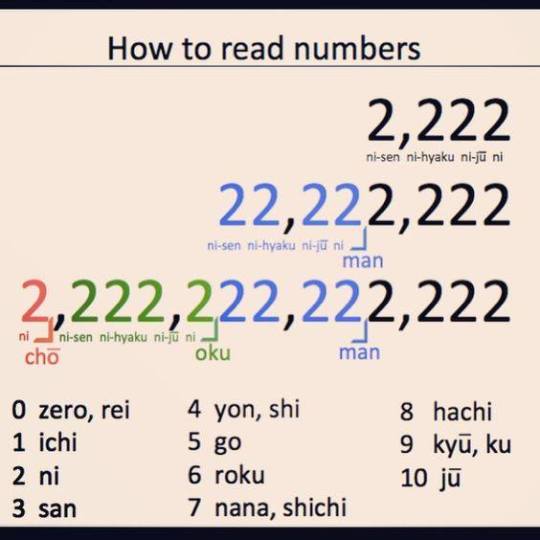
🔢 🔣 Reading the numbers in Japanese is confusing! Here is a small infographic to help you remember! For more Japanese resources click here ➡️ https://www.japanesepod101.com/?src=tumblr_numbers_021918
1K notes
·
View notes
Photo

Kanji is easy? 漢字は簡単?
虫 mushi - insects
#kanji #nihongo #japanese
595 notes
·
View notes
Photo
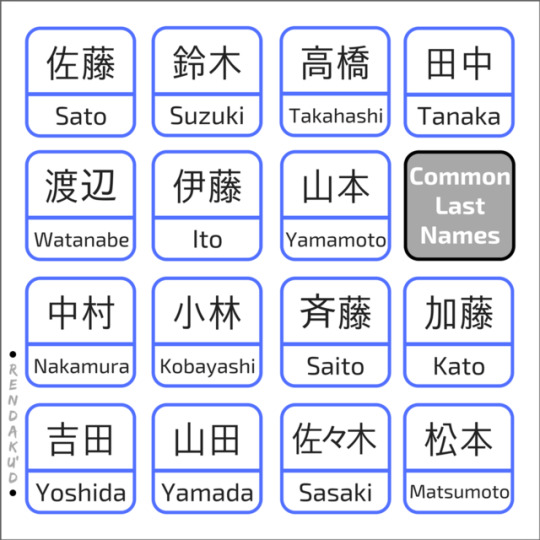
❀✿ Common Japanese Last Names ❀✿
Sato 佐藤
佐 (sa) : help, aid
藤 (tou) : wisteria
Suzuki 鈴木
鈴 (suzu) : bell
木 (ki) : tree, wood
Takahashi 高橋
高 (taka) : tall, high
橋 (hashi) : bridge
Tanaka 田中
田 (ta) : field, rice paddy
中 (naka) : middle
Watanabe 渡辺
渡 (wataru) : cross, ferry
辺 (be) : area, border
Ito 伊藤
伊 (i) : this, that one
藤 (tou) : wisteria
Yamamoto 山本
山 (yama) : mountain
本 (moto) : base, root, origin
Nakamura 中村
中 (naka) : middle
村 (mura) : town, village
Kobayashi 小林
小 (ko) : small
林 (hayashi) : forest
Saito 斉藤
斎 (sai) : purification, worship
藤 (tou) : wisteria
Kato 加藤
加 (ka) : add, increase
藤 (tou) : wisteria
Yoshida 吉田
吉 (yoshi) : lucky, good
田 (ta) : field, rice paddy
Yamada 山田
山 (yama) : mountain
田 (ta) : field, rice paddy
Sasaki 佐々木
佐 (sa) : help, aid
々 : repeater kanji
木 (ki) : tree, wood
Matsumoto 松本
松 (matsu) : pine tree, fir tree
本 (moto) : base, root, origin
〆
3K notes
·
View notes
Video
youtube
Learn very important Japanese Phrases - 3 ways to say “Wait a minute” in Japanese(◕ω◕)♪
https://www.youtube.com/watch?v=_PQhkABZFQs
33 notes
·
View notes
Photo




(via Tons of Free Japanese Grammar & Vocabulary PDF Lessons)
77 notes
·
View notes
Text
Things you might not know about particle を
For explanations regarding particle WA , O , and GA, check out our blog lessons index . If you just start learning Japanese and don’t know how to start, check our article here.
Today I want to share explanations about particle を. For full explanation you can check out http://crunchynihongo.com/japanese-particle-wo/
°˖✧◝(⁰▿⁰)◜✧˖°

It is read as ‘o’ and is used to mark something which is being affected by action/movement explained after the particle. Take a look at the example to easily understand the pattern.
ジョンは高いカメラを買います
John wa takai kamera o kaimasu
John buys expensive camera.
>> The を shows that the action of [kaimasu: buy] is being done to [takai kamera: expensive camera]

Most books/lessons tells you that を is direct object marker. It’s quite true in most case, but if you think of it as equivalent of object marker, you will be confused to some of ‘o’ usage. It make more sense to say that を let us know as to what the action mentioned is being applied to. Here’s some example:
Example 1:
その交差点を右に曲がってください。
Sono kousaten O migi ni magatte kudasai
Please turn right at that intersection.
>> It will be confusing to think that [Sono kousaten : That intersection] is and object of [migi ni magatte kudasai : please turn right ].
>> But if you think of it like this, it makes sense right?
The を shows that the action of [migi ni magatte kudasai : please turn right ] need to be done at [Sono kousaten : That intersection].

Example 2:
を cannot be use for intransitive verbs such as ‘furu (to fall as in the rain)’. In this case you use が. Basically, intransitive verbs means that the action is not done at something/object. It’s just happened! That is why you cannot use ‘o’ with verb like this. And instead you use ‘ga’!
雨が降ります
Ame ga furimasu
The rain falls

>> You can’t use ‘o’ because the act of ‘fall’ is not done to the rain. The rain just falls!
And here’s another example sentence which create much confusions…
私は英語が分かります。
Watashi wa eigo ga wakarimasu.
I understand English
>>’Wakaru’ is actually an intransitive verb which doesn’t allow objects. Although it’s being translate as “I understand English”. The real literal meaning is “As for me, English is understandable”.This is applied to all similar verbs!
You can use を in ‘hanashimasu’ (speak) normally.
私は英語を話します。
Watashi wa eigo o hanashimasu.
I speak English
…………………………………………
We hope that it helps you to understand about this particle easily!
Read the full explanations at our blog here . Also read explanations regarding Particle WA and GA. Check our lessons index!
Happy Learning!!
。゚✶ฺ.ヽ(*´∀`*)ノ.✶゚ฺ。
2K notes
·
View notes
Text
Japanese Word of the Day
#Japanese #WordoftheDay
国中
(くにじゅう/kunijuu)
‘all over the country’
Example: 侍が2人 現れたって国中 今 大騒ぎになってんの!
— Learning Japanese (@LearnJPBOD) December 11, 2017
31 notes
·
View notes
Photo

JLPT N5 Vocabulary List
31 notes
·
View notes
Photo
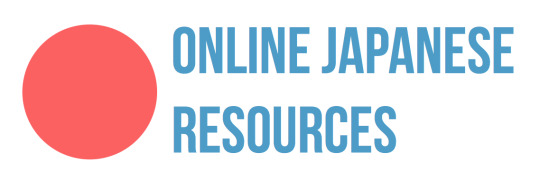
Hello! As an IB Japanese student, I wanted to create a masterpost of resources I’ve found throughout the years for FREE online Japanese learning. I hope this list is of some help to you. Of course, feel free to share your own favourites too.
* = my most used
GENERAL:
*JOSHU - resource for learning everything
*NIHONGO eな - database of Japanese links/resources
Nihongo wo Narau - resource for learning everything
ALPHABET/VOCABULARY:
*Clozemaster - learning vocabulary in context
Core Japanese Vocabulary - memrise course for vocabulary
CosCom - basic vocabulary lists
*Jisho - dictionary (literally use this everyday)
Kanji Alive - kanji search dictionary
Kanji Learner’s Course Key - 7200 kanji google spreadsheet
Learn Japanese - vocabulary lists
Linguee - languages dictionary
*Read the Kanji - read kanji in context of sentences
*Real Kana - customizable kana learning game (favourite for beginners)
*Renshuu - kanji learning flashcards
*Rikaikun - chrome extension for hover kanji dictionary
Takoboto - dictionary
WaniKani - kanji learning game
YYNIHONGO - vocabulary picturecards
GRAMMAR:
Basic Japanese Cheat Sheet - condensed grammar poster
JGram - grammar tables database
Maggie Sensei - grammar blog (seems to be offline now)
PuniPuniJapan - grammar/vocabulary/daily phrase blog+videos
*Tae Kim’s Guide to Learning Japanese - grammar lesson posts
*Visualizing Japanese Grammar - grammar video illustrations (so good)
*用例 - search for example sentences containing specific characters
READING PRACTICE:
AddRuby - adds furigana to Japanese websites
BuzzFeed Japan - pop culture news outlet in Japanese
Hiragana Times - news website (intermediate)
Language in Motion - Japanese short stories
*NEWS WEB EASY - NHK news (easy version with furigana)
Rosa’s Daily Life - daily life blog (no longer updated but still useful)
UtaTen - Japanese song lyrics database
LISTENING/CULTURE:
Bilingirl Chika - youtube channel for cultural/grammatical aspects
*Cooking with Dog - youtube channel for Japanese cuisine
*Erin’s Challenge - beginner live-action learning videos
*Kiss Anime - free anime streaming (absolute favourite)
Japanese in Anime and Manga - interactive anime/manga analysis
Japanese Level Up - English Japanese culture blog
*MATCHA - Japan travel magazine (many languages including ‘easy jap’)
*My Kikitori - listen to Japanese roleplays (my teacher loves this!)
*Simon and Martina - youtube channel of Canadian couple in Japan
Tofugu - English Japanese culture blog
LANGBLRS:
@aringoaday - daily illustrated vocabulary flashcards
@ithinkimlearningjapanese - learning through LINE conversations
@japaneselanguagestudygroup - compilation of resources
@japanesetest4you - interesting phrase flashcards
@kanji-a-day - daily handwritten vocabulary flashcards
@myjapanesewordoftheday - cultural/important word posts
@nihongogogo - great all-in-one resource!
@nihongokudasai - another great all-in-one resource!!
@nihongoround - cool Japanese comics
@nihononthego - another another great all-in-one resource!!!
@ryohkei - daily calligraphy vocabulary flashcards
Also definitely reach out to other Japanese speakers (perhaps the owners of these amazing tumblrs), because one of the best ways of learning a language is from interaction
Here’s all I recommend so far, but there’s certainly a ton of other resources out there. With enough effort, the daunting and difficult task of learning Japanese is awfully fun.
+ other links:
my #japanese tag
history of japan - informative 9min youtube video (nsfw: swearing)
How To Cite Japanese Sources - for writing Japanese papers
1K notes
·
View notes
Photo
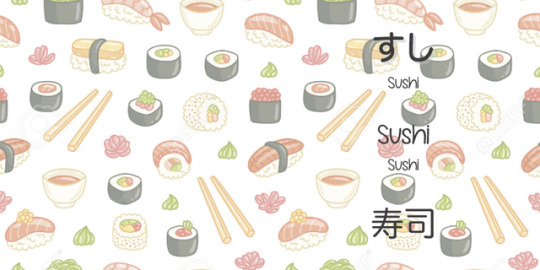
📕 すし 📙 Sushi 📒 Sushi 📗 Sushi 📘 寿司
130 notes
·
View notes
Photo

Months in Japan!
PS: If you want to learn #Japanese language the best way, click here!
423 notes
·
View notes
Photo

Learning Japanese Master Post #02.
Here’s a master post for video lessons #51-#100 in the Learning Japanese video series, all view-able for free on YouTube! That’s right, each topic gets its own episode! All arranged in order and linked below. Check out all 200+ video lessons at the official YouTube channel here and the other Master Posts: 1
youtube
Conjugations of Desu (です)
Conjugating い-Adjectives
Conjugating な-Adjectives
How-to Say “(I/We) want X” and “Do you want X?” (Xがほしいです)
How-to Say “X wants Y” (Third Person) (XはYをほしがっている) (cont.)
“VERBAL NOUN + に(行く/来る)” as “Going/coming to do VERBAL NOUN”
Using adjectives as adverbs
How-to say “try to do VERB” (VERB て-Form + みる)
How-to say “in order to VERB/for the sake of VERBing” (VERB Dictionary Form + ために)
Potential Form (Verb Conjugation)
て- Form VERB + いる as “has VERB-ed” (Resultant State)
X ので Y as “Because X, Y”
How-to say “VERB while VERBING” with Pre-ますForm VERB + ながら + VERB
How-to use しまう to emphasize finality of an action (て-Form + しまう)
How-to say “to VERB2 without doing VERB1” (Negative ない-Form VERB1 + で + VERB2)
How-to say “it is (easy/hard) to do VERB” with Pre-ます-Form VERB + (やすい/にくい)
The たり-Form - たり-Form V1 + たり-Form V2 + する (Do VERB1, VERB2, and other such things)
The て-Form as “and” (CLAUSE1 + て + CLAUSE 2 as “CLAUSE1 and CLAUSE2”)
X までに as “by the time of X”
How-to say “become (ADJECTIVE/NOUN)” with (ADJECTIVE/NOUN) + なる
How-to say “make X (ADJECTIVE/NOUN)” with X を (ADJECTIVE/NOUN) + する
How-to say “Before CLAUSE1, CLAUSE2” (Dictionary Form C1 + 前に + C2)
How-to say “After CLAUSE1, CLAUSE2” (た-Form C1 + 後で + C2)
How-to say “do nothing but VERB” (て-Form VERB + ばかりいる)
How-to say “VERB nothing but NOUN” (NOUN + ばかり + VERB)
How-to say “start VERBing” (Pre-ます-Form VERB + 始める)
How-to say “finish VERBing” (Pre-ます-Form VERB + 終わる)
(Dictionary/Negative-ない)-Form VERB + ようにする as “make an effort (to/not to) VERB”
(Dictionary/Potential/Negative-ない)-Form VERB + ようになる as “it has become that”
How-to say “I think that” (Plain-Form + と思う)
Volitional Form (Verb Conjugation)
Plain Form + かも知れない as “(may/might/possibly) be _”
(Pre-ます-Form VERB/Stem-Form ADJECTIVE) + すぎる as “(VERB too much/too ADJECTIVE)”
Volitional-Form VERB + と思う as “I think I will VERB”
“A (is/isn’t) as ADJ as B” - AはB(と同じぐらい ADJ/ ほど Negative-Form ADJ)
Plain-Form A + のに + B as “Even though A, B”
AてからB as “After A, B”
Plain-Form + でしょう as “probably ___”
How-to say “should do VERB/it’s best to do VERB” (た-Form VERB + 方がいい)
How-to say “should not do VERB/it’s best to not do VERB” (ない-Form VERB + 方がいい)
Conditional ば-Form (Verb Conjugation + Adjective and Noun Conjugation)
ば-Form CLAUSE1 + CLAUSE2 as “If CLAUSE1, CLAUSE2”
Negative ば-Form (なければ) CLAUSE1 + CLAUSE2 as “If not CLAUSE1, CLAUSE2”
たら-Form: C1たらC2 as “After C1, C2” or “If C1, C2” (pt. 1 of 2)
たら-Form: C1たらC2 as “After C1, C2” or “If C1, C2” (pt. 2 of 2)
(Pre-ます-Form VERB/Stem-Form ADJ) + そう(です/だ)as “it looks like ____” (pt. 1 of 2)
(Pre-ます-Form VERB/Stem-Form ADJ) + そう(です/だ)as “it looks like ____” (pt. 2 of 2)
Plain-Form CLAUSE + (そう/だ) as “heard that ___”
て-Form VERB + おく as “to do VERB ahead of time”
How-to ask/allow/deny permission to do something (て-Form VERB + もいいですか)
Support Learning Japanese on Patreon!
Please do consider checking out our milestone goals on Patreon and becoming a patron to support the continuation of this video series and expansion of the curriculum!
https://www.patreon.com/learningjapanese
This video series is presented by becauseofdreams
http://becauseofdreams.com/
8K notes
·
View notes
Photo
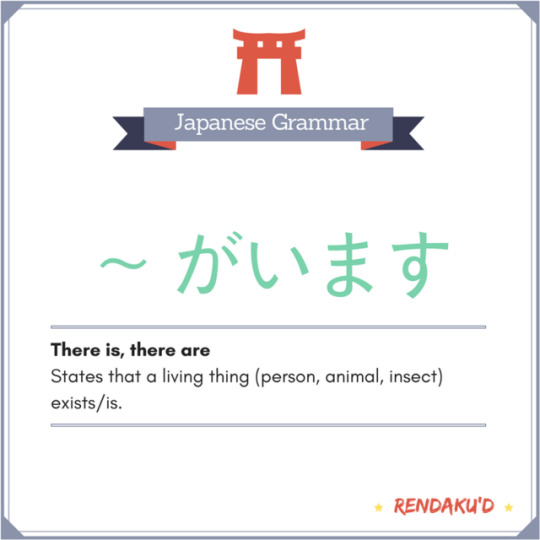
JLPT N5 Grammar ʕ´•ᴥ•`ʔ
~がいます - Expression
States that a living thing exists/is.
が is a particle used to show the subject of the sentence.
います is a verb that expresses a living thing “is” or “exists”. Living things include people, animals, and insects. It’s not used for plants (that uses あります).
Meanings:
There is, there are
How to:
Noun + がいます。
ねこがいます。There is a cat.
Placeに Nounがいます。(To show place of existence)
としょかんにクリスさんがいます。Chris is in the library.
Different forms of います:
いる - plain positive, present
いない - plain negative, present
います - polite positive, present
いません - polite negative, present
いた - plain positive, past
いなかった - plain negative, past
いました - polite positive, past
いませんでした - polite negative, past
Examples:
とりがいます。There is a bird.
きょうだいがいますか?Do you have any siblings?
うちのなかにてんとうむしがいました。There was a ladybug in the house.
371 notes
·
View notes
Photo
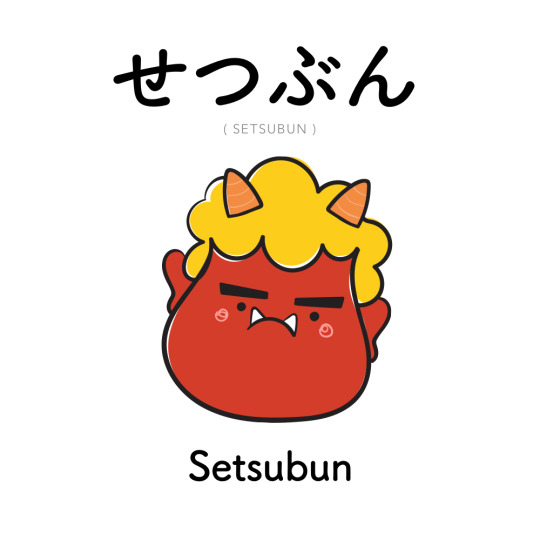
[23] せつぶん | setsubun | setsubun
Setsubun, celebrated yearly on February 3 as part of the Spring Festival, can be thought of as a sort of New Year’s Eve.
Setsubun comes along with a special ritual meant to cleanse away all the evil of the former year and drive away disease-bringing evil spirits for the year to come.
During this special ritual called mamemaki (literally “bean scattering”) roasted soybeans (called “fortune beans”) are thrown either out of the door or at a family member wearing an Oni (demon) mask, while people chant “Demons out! Luck in!” (Oni wa soto! Fuku wa uchi!?) and slam the door.
435 notes
·
View notes
